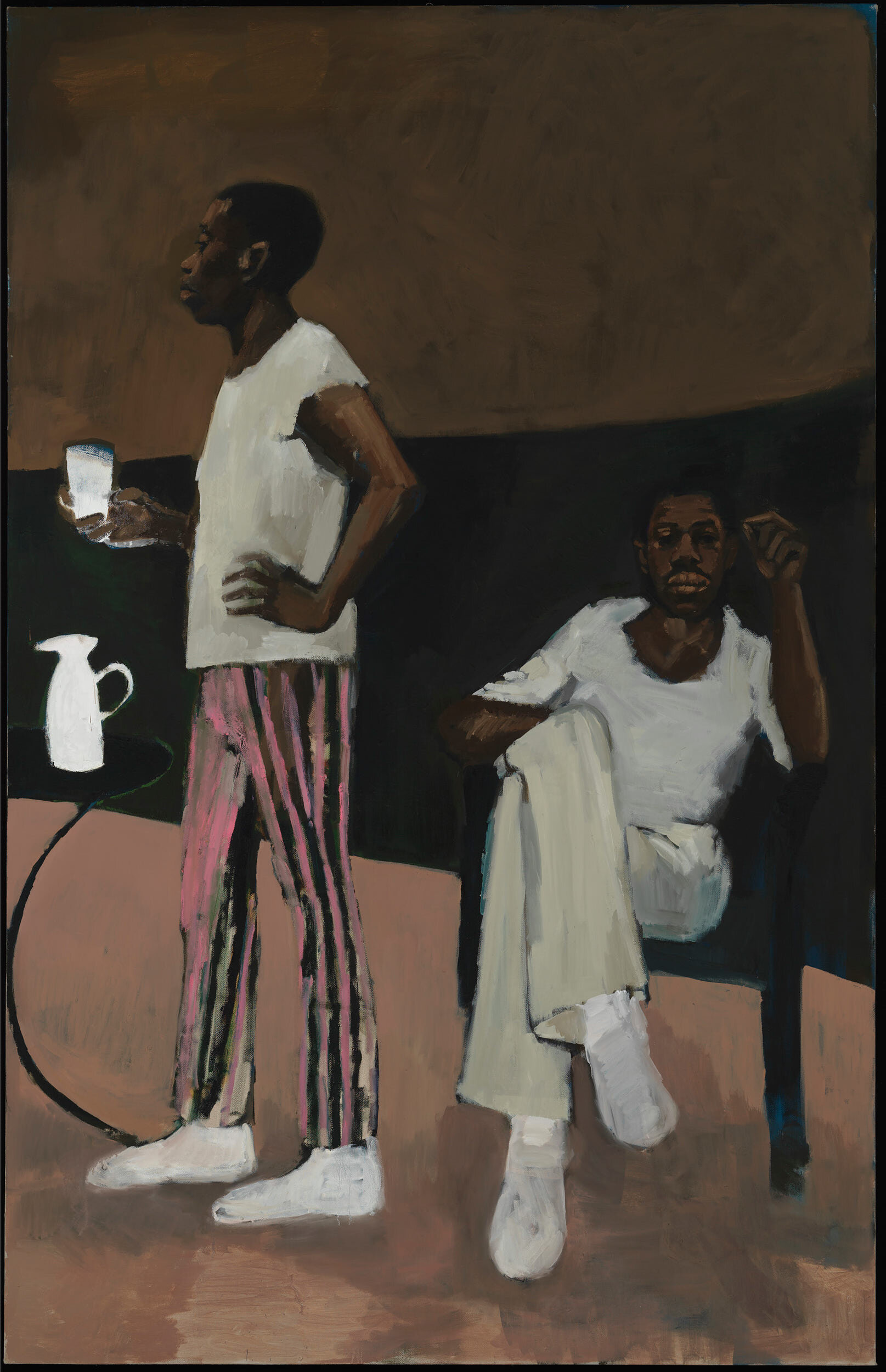The Colour of Black — Lynette Yiadom-Boakye
As anyone who has ever painted skin will know - it is not white, and it is not black. Lucien Freud observed and examined the complexion of the English Rose, painting the skin with a palette of blues, pinks, yellows and greens. Lynette Yiadom-Boakye paints black skin similarly - using oranges, blues, yellows and red; she paints it with the same mastery as those who have come before her, those who fill the canons of Art History.
Image Courtesy of The Artist, Corvi-Mora, London and Jack Shainman Gallery, New York
Image Courtesy of The Artist, Corvi-Mora, London and Jack Shainman Gallery, New York
Displaying a great understanding of colour, the tone, texture and beauty of the skin are described with an observant eye and a well-honed colour palette. Using just one tone, Yiadom-Boakye can describe skin and fabric, background and foreground - making evident the differences in their depth, structure and meaning.
At a glance, black seems to dominate many of the canvases, however, Yiadom-Boakye never paints with pure black pigment – instead she mixes brown with blue to create rich and vibrant hues. Each composition is built out of colours, and there is a dance, a negotiation and a chemistry between them that comes together thanks to an innate understanding of the way that colours sit or play together.
By graduating the intensity of the darkness, Yiadom-Boakye finds the form and personality of her subjects. The characters come to life through a combination of found imagery and drawings from life, as well as from the artist’s imagination and her deep capacity for storytelling. Each painting is a process - a construction - that is worked out by the artist and delighted in by the viewer.
Inventing characters and scenes, Yiadom-Boakye’s paintings feel self-explanatory - to be read, felt, but not to be ‘understood’ or picked apart. There is a sense of a story or narrative, but it is not concrete; it is a story that builds across a body of work rather than being held individually within each work.
Image Courtesy of The Artist, Corvi-Mora, London and Jack Shainman Gallery, New York
The fictional characters that populate the paintings are an accumulation of different people, poses and atmospheres, and the manner in which they are painted matches this improvisational and imaginative process. It feels as if Yiadom-Boakye is working the painting out as she goes - finding the composition, the light, the tone - through the paint itself. Created from a series of actions and reactions, the works hum with energy and life.
In order to retain the integrity of each piece, Yiadom-Boakye does not revise or revisit her paintings once they are complete, and so the quality of each mark is preserved - acting as a document of the moment that it was created. Miles Davis once noted that in musical compositions, “it’s not the note you play that’s the wrong note – it’s the note you play afterwards that makes it right or wrong”. Working in an informed yet intuitive way, Yiadom-Boakye paints like jazz musicians play – her technical ability allowing her the freedom to improvise.
Image Courtesy of The Artist, Corvi-Mora, London and Jack Shainman Gallery, New York
The worlds of dance and theatre are often evoked in Yiadom-Boakye’s paintings. Men in black tights and women in dancewear - there are tutus and neck ruffs, and hair that is neatly tied back. There is a sense of the warm-up, or of being backstage, as the figures lounge, lean and perch – they enjoy a quick cigarette, they pass the time.
Image Courtesy of The Artist, Corvi-Mora, London and Jack Shainman Gallery, New York (Left & Right)
Characteristic of Yiadom-Boakye’s work are the flashes of white that puncture the darkness. White vests, white shirt-collars and the white horizontal stripes in a traditional mariniere t-shirt are commonplace in her work. The teeth revealed by a smile, the white of an eye or the cigarette that hangs from between fingers - white is used as a bold accent - a highlight, in the most traditional sense.
Painting, or even closely observing, a black - or white - object will illuminate the fact that black is not, in fact, black, and white is not white. Although the term ‘black and white’ is often used as an illustration or embodiment of ‘the opposite’, Yiadom-Boakye’s paintings show that black and white are more similar, interesting, rich and complicated than one first imagines.
Image Courtesy of The Artist, Corvi-Mora, London and Jack Shainman Gallery, New York
Image Courtesy of The Artist, Corvi-Mora, London and Jack Shainman Gallery, New York
Image Courtesy of The Artist, Corvi-Mora, London and Jack Shainman Gallery, New York
A Mind For Moonlight by Lynette Yiadom-Boakye
is currently exhibited at Corvi Mora, London, until 26 October 2019
You may find more information on the exhibition
by visiting their website www.Corvi-Mora.com
Image Courtesy of The Artist, Corvi-Mora, London and Jack Shainman Gallery, New York
















